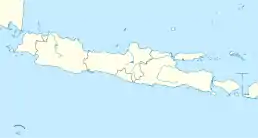Borobudur
Borobudur, or Barabudur is a 9th-century Mahayana Buddhist temple in Magelang, Central Java, Indonesia. It is the world's largest Buddhist temple.[1][2][3]
| Borobudur | |
|---|---|
 Borobudur, a UNESCO World Heritage Site | |
| Location | Magelang, Central Java |
| Coordinates | 7.608°S 110.204°E |
| Built | Originally built in the 9th century during the reign of the Sailendra Dynasty |
| Restored | 1835 |
| Restored by | Sir Thomas Stamford Raffles |
| Architect | Gunadharma |
| Type | Cultural |
| Criteria | i, ii, vi |
| Designated | 1991 (15th session) |
| Part of | Borobudur Temple Compounds |
| Reference no. | 592 |
| State Party | |
| Region | Southeast Asia |
 Location within Java  Borobudur (Indonesia) | |
The temple has nine stacked platforms, six square and three circular, topped by a central dome. It is decorated with 2,672 relief panels and 504 Buddha statues.[4] The central dome is surrounded by 72 Buddha statues, each seated inside a perforated Stupa.
Related pages
- Sewu temple
References
- "Largest Buddhist temple". Guinness World Records. Guinness World Records. Retrieved 27 January 2014.
-
Purnomo Siswoprasetjo (4 July 2012). "Guinness names Borobudur world's largest Buddha temple". The Jakarta Post. Archived from the original on 5 November 2014. Retrieved 27 January 2014.
{{cite web}}: CS1 maint: unfit URL (link) - "Borobudur Temple Compounds". UNESCO World Heritage Centre. UNESCO. Retrieved 28 December 2008.
- Digital Preservation of Borobudur’s Narrative Relief Wall UNESCO Seminar, Hary Gunarto, Jakarta, 2011.
This article is issued from Wikipedia. The text is licensed under Creative Commons - Attribution - Sharealike. Additional terms may apply for the media files.